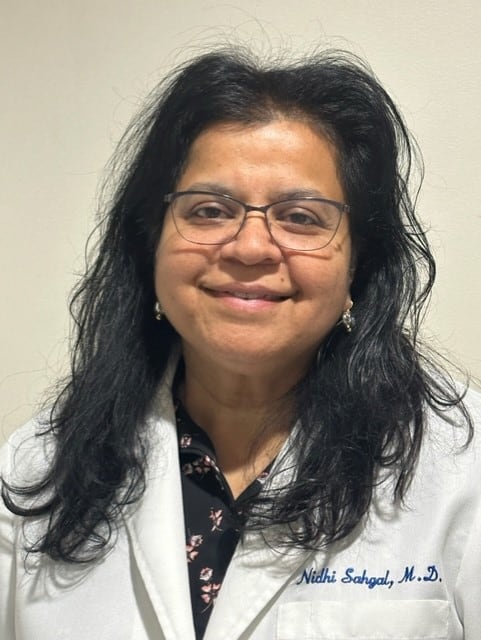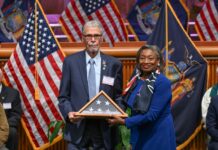
Dr. Nidhl Sahgal
By Dan Murphy
St. John’s Riverside Hospital recently held a webinar during October, which is Breast Cancer Awareness month. The webinar, Fight Against Breast Cancer: The Progress We’ve Made, featured a discussion with Dr. Nidhi Sahgal, a breast surgeon for 22 years. Dr. Sahgal has dedicated her practice to breast diseases and breast surgery.
Is an impact being made fighting breast cancer and early detection rates?
“Every month when October comes around, everyone wears pink and has been touched by this disease in some form. My hope is that in October, women go for their mammograms and discuss their risk and family history with their doctors. We know one thing about Breast Cancer for a fact: The earlier we find it, the better we can cure it and save more lives. “
Dr. Sahgal said that 1 in 8 women present with Breast Cancer, a number that has held steady for a while, but “our detection rate has increased every year because more women are getting Mammograms.”
“Your biggest risk of breast cancer is being a woman, and aging is the second highest risk. Early detection is key in the treatment of breast cancer. Women should get an annual mammography at age 40 to help with early detection. If the breast tissue is not dense, that should be the only test you need.”
“If the breast tissue is dense, we also recommend an ultrasound for a better assessment. If a woman is at high risk, they should start screening ten years earlier than their youngest relative with a positive finding on mammogram,” said Dr. Sahgal.
A woman can be high risk based on their genetics or their family background. Dr. Sahgal divided the two categories into genetic breast cancer and hereditary breast cancer.
“Genetic breast cancer is less common, but it’s important to do the risk assessment because there are specific genes that elevate one’s risk for breast cancer.
“Conversely, if I have a patient whose mother and grandmother have had breast cancer but no genetic mutation is found, I put that into the hereditary category. There is something there that we may not be able to classify genetically.”
Dr. Sahgal explained, “Our detection rate has increased every year because more patients are getting mammograms. In stage 1-which is very early, the survival rate over 20 years is 90%. In stages 2,3 and 4, the survival rates go down. So we do know that survival is improved the earlier we find it.”
St. John’s Riverside Hospital has both Digital Mammography and 3D Mammography. “With the advent of 3D Mammography, there is value to it for women with dense breasts, as well as for detecting some other things that a digital mammography can’t. The younger you are, the more dense your breasts tend to be, so there is a need for 3D Mammography in some of our patients.”
If an abnormality is found, Dr. Sahgal can perform a non-invasive biopsy. “One of the biggest fears women have about testing is that they will have a scar if a biopsy is needed. This is untrue; there is no scar to make a diagnosis.”
“If a diagnosis of cancer is made, the first step is to see a surgeon, who will go over your entire history and see if additional testing is needed. After that, the next step for most women is surgery,” said Dr. Sahgal.
“There are several types of breast cancer surgery, including lumpectomy and mastectomy. A lumpectomy is the removal of the cancerous tissue in the breast and lymph nodes under the arm but not the entire breast. This type of surgery has been around for thirty years, but what’s new is we can do less and less lymph node surgery because we can better identify which lymph nodes are the first ones cancer would go to and only remove those.
90% of breast cancer comes from the ducts in the breast, and 10% comes from the glands in the breast. Breast cancer has three biological markers that we test for that help guide treatment and also grade the cancer to assess how aggressive it is. Grades range from 1 to 3, three being the most aggressive. The grade not only tells us how aggressive the disease is, but it also helps guide treatment.
Dr. Sahgal explained that usually, women who choose a lumpectomy have radiation treatment after surgery. “A lumpectomy followed with radiation after surgery, for women under 70, is comparable to a mastectomy in reducing the chances of the cancer coming back in most women with a single breast cancer diagnosis.
The other form of breast cancer surgery is a mastectomy, which is the removal of the entire breast. Dr. Sahgal said that while fewer mastectomies are being performed today because of better outcomes from lumpectomies, “a mastectomy is always an option. Full removal of all breast tissue reduces the need for radiation therapy post-surgery, which some women want to avoid, so it’s an operation that works well. Further, we always follow up with a plastic surgeon to discuss reconstruction options with women who make that choice.”
The goal of any breast cancer surgery is to remove all diseased cells. After surgery, the patient is sent to the medical oncologist at St. John’s to determine the next best step. Depending on the patient, it could be as simple as daily oral medication, and other times, it’s chemotherapy (medicine given intravenously). Other post-surgery treatments include immunotherapy. It depends on the scenario, the stage of the cancer, the age of the patient, and the health of the patient.
One test that Dr. Sahgal and the Oncology Department of St. John’s Riverside Hospital use in certain situations is an Oncotype recurrence score. “It helps to guide us as to what the chances are that this tumor will come back. This helps us determine the best medical treatment for breast cancer and is an amazing advancement in the medical oncology world.”
Of the 300,000 breast cancer patients in the country every year, 1% are men. “Symptoms for most men who have breast cancer have chest irritation, which could resemble a rash that itches or is painful. Many times, it is discovered by their primary care provider. If you have those symptoms, then you should let your doctor know. Also, if your mother had breast cancer, you should be vigilant because the genes for other cancers, such as prostate and pancreatic cancer, can be connected to breast cancer,” said Dr. Sahgal.
What can people do to prevent breast cancer? Dr. Sahgal says, “A high-fiber, low-fat diet helps reduce the risk of many cancers. Staying active is also key; even if it’s 10 minutes of walking outside daily, the more you stay active, the less the chance of cancer. Breastfeeding has also been shown to help reduce the risk of breast cancer in women, but of course, some of us can’t control this. “
Dr. Sahgal said all the media attention about breast cancer awareness month has resulted in “a much higher awareness from people about the importance of testing. October begins my busiest time of year because women are going for mammograms during Breast Cancer Awareness month. While many women are still hesitant because of the fear of the unknown and other stigmas around breast cancer treatment, we must continue to fight and be proactive about our health, and you can make a difference.”
To make an appointment for a mammography, call St. John’s Riverside Hospital’s Central Scheduling at (914) 964-4329 or for a Breast Surgeon Referral call (914) 964-4DOC (4362).
Dr. Nidhi Sahgal is a fellowship-trained, board-certified breast surgeon who specializes in the treatment of breast cancer. With over 22 years of experience both at Essen Health Care and St. John’s Riverside Hospital, she has performed hundreds of successful breast surgeries and helped countless patients survive their diagnosis of breast cancer. Dr. Sahgal received her medical degree from Georgetown University School of Medicine and completed her General Surgery training at North Shore University Hospital and fellowship training in breast surgery at Stanford University Hospital.





